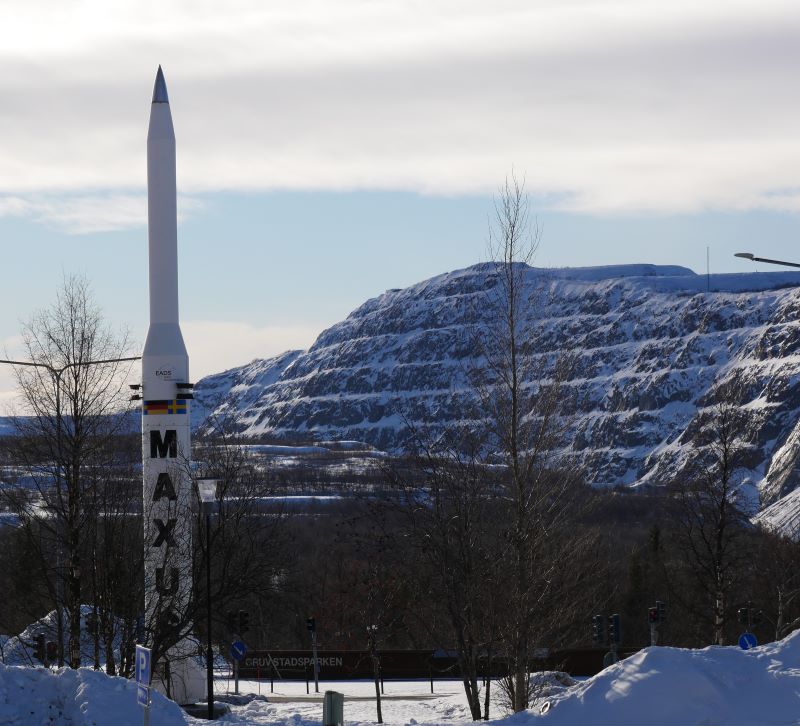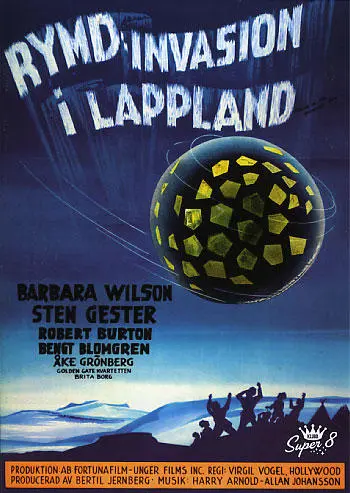
By Chakad Ojani
In the 1959 Swedish-American science fiction film Space invasion of Lapland, two scientists travel to northern Sweden upon hearing about the landing of a mysterious extraterrestrial object. As viewers, we have already had a glimpse of the latter: the film opens with Sámi reindeer herders awing at the glowing round object as it travels across the sky, before finally crashing into a snow-covered mountain. The movement of the presumed meteorite strikes us as rather eerie and not at all in accordance with the way an actual space rock would behave upon entering into the atmosphere. And indeed, the puzzle that the travellers have been called upon to unravel ultimately exceeds the grasp of modern science, as the object turns out to be an alien spaceship.
A conversation unfolds between the two scientists onboard a plane bound for northern Sweden. Nodding at a boat visible from the plane’s window, the famous geologist, Dr. Wilson, asks his fellow traveller, Dr. Engström, whether he knows what it is. “Ore boats from the Kiruna ore mines, the richest iron deposit in the world”, Dr. Engström replies, upon which Dr. Wilson speculates: “[D]o you think that the magnetic attraction of the mines could have any bearing on the meteor falling there?” His colleague seems sceptical, replying, “Come on doctor, like making the meteor skid across the snow for miles?” A brief moment of deliberation follows, before Dr. Wilson finally asks: “Who said it had to be a meteor?”
 The Swedish cover of Space invasion of Lapland.
The Swedish cover of Space invasion of Lapland.
There are several topics of anthropological interest appearing throughout this black-and-white film – not least gender, science and modernity, and representations of the Sámi and the Circumpolar North. However, in this short text I wish to hone in on the speculative relation drawn by Dr. Wilson between the extraterrestrial and the Kiruna iron ore mine. As it happens, during my fieldwork in this subarctic city I have come across many such links among my interlocutors too.
For example, for reindeer herders working in the vicinity of the Swedish rocket launch site’s impact area, space often gains a negative relation to mining in that the spaceport helps holding new mining initiatives at bay. While critical of its placement on their lands and the various forms of disturbance created by its surrounding infrastructure, the herders occasionally highlight the launch site’s utility. Only a few years ago, the spaceport became the reason for halting new mining projects in the area. In a context long characterised by resource extraction, discrimination, and marginalisation, one exploiter helps to prevent herders’ ever-shrinking grazing areas from further destruction by other exploiters.
In contrast, local politicians and space lobbyists see a potentially positive relation between mining and the space industry, calling for stronger synergies between the two. These actors have brought to my attention how both industries are not only hi-tech but also operate in extreme environments, “above the atmosphere” and “far below the ground”. For them, the connection between mining and space seems almost self-evident. In fact, there have already been several collaborations, for instance an experiment conducted by local scientists who made use of a sealed-off mining area for the detonation of dynamite, the vibrations of which were then measured with infrasound microphones attached onto stratospheric balloons. And as it turns out, the analogy often drawn by my interlocutors between space and the underground is not in any way unique to this particular location. It also predicates space-analogues undertaken in cave-environments elsewhere in the world (see Park 2016).
But the relation between the Kiruna iron ore mine and space exploration is also historical. The Swedish satellite launch infrastructure, which is currently under development, builds upon an already-existing scientific infrastructure purposed for atmospheric research and space physics – an infrastructure that is renown for generating important data on aurora borealis, among other space-related phenomena. This infrastructure, in turn, rests on a considerably older history of mining, which stretches back to 17th-century copper and silver mines but perhaps most significantly to the late-19th century establishment of the worlds largest underground iron ore mine (see López 2021). It was to a great extent the existence of what is essentially the mine’s surrounding infrastructure that motivated the placement of the rocket base in this particular region in the 1960’s. Hence, to the extent that Kiruna can be considered a “space town” (Backman 2015), then this has been made possible by a more long-standing infrastructure of resource extraction. The vertical territorial understanding (Braun 2000) reflected by contemporary developments around space exploration draws on a longer history of “infrastructural mediation” (Ruiz 2021).
 A MAXUS rocket standing next to the Kiruna city centre, with the iron ore mine visible behind. Photo by author.
A MAXUS rocket standing next to the Kiruna city centre, with the iron ore mine visible behind. Photo by author.
In his book Space in the tropics, Redfield (2000) investigates the relation between two seemingly separate phenomena in French Guiana: an old penal colony that operated between 1852 and 1943, on the one hand, and the contemporary spaceport from where the European consortium rocket Ariane is launched, on the other hand. Redfield asks, “what might it reveal that [these] different things happen in the same place?” The same question can be posed about mining and space in Kiruna, albeit not without paying close attention to the situated, historical specificities exhibited by the construction of “welfare frontiers” in the Nordics (Hastrup and Lien 2020).
Yet, here I would also like to direct attention to the connections that my interlocutors themselves draw between things. A PhD student at the local space campus offered a captivating analogy. Sitting in his office, we were chatting away about everything from aurora borealis and housing in Kiruna to the navigation of small satellites for deep space exploration, the latter of which was the subject of his doctoral studies. As the conversation wore on, he told me that he did not really believe in space colonisation in the way this is usually envisaged. He did not think that space settlements would emerge as ends in themselves but rather as consequences of off-Earth mining. He brought home this point by way of comparison, suggesting that this is not very different from the way Kiruna did not exist prior to the establishment of the local mine, hinting that there could be no significant reason to settle down here prior to the emergence of a mining infrastructure. Hence, reminiscent of Dr. Wilson’s speculation about the connection between the extraplanetary and the local iron ore mine, my interlocutors too make connections, contrasts, and analogies between mining and outer space to envisage and prefigure things unknown, far away, or yet-to-be.
Scholars have highlighted how satellite technology has helped creating and reconfiguring environments on Earth, often unintendedly (Gärdebo 2019). By offering a view from above and without, our ways of conceptualising and relating to our surrounds become intrinsically modified. In this brief text, I have tried to elicit a somewhat different trajectory, namely, how grounded, planetary milieus become infrastructures for envisioning space. These are “the terrestrial localit[ies] of outer space” (Messeri 2016: 163); places and relations – in this case the infrastructural history of a mining town – that inform extraplanetary imaginaries. In Kiruna, the local mine occasionally serves as a “speculative device” (McCormack 2018) for envisaging the specific unfoldings of a future beyond Earth.
References
Backman, Fredrick. 2015. Making place for space: A history of ‘Space Town’ Kiruna 1943-2000. Umeå: Umeå University.
Braun, Bruce. 2000. “Producing vertical territory: Geology and governmentality in late Victorian Canada”. Ecumene 7 (1): 7-46.
Gärdebo, Johan. 2019. Environing technology: Swedish satellite remote sensing in the making of environment 1969-2001. Stockholm: KTH.
Hastrup, Frida, and Marianne Elisabeth Lien. 2020. “Welfare frontiers? Resource practices in the Nordic Arctic Anthropocene”. Anthropological Journal of European Cultures 29 (1): v-xxi.
López, Elisa Maria. 2021. Transforming Kiruna: Producing space, society, and legacies of inequality in the Swedish ore fields. Uppsala: Uppsala University.
McCormack, Derek P. 2018. Atmospheric things: On the allure of elemental envelopment. Durham, NC: Duke University Press.
Messeri, Lisa. 2016. Placing outer space: An earthly ethnography of other worlds. Durham, NC: Duke University Press.
Park, William. 2016. “Why caves are the best place to train astronauts”. BBC, November 30. https://www.bbc.com/future/article/20161130-why-caves-are-the-best-place-to-train-astronauts.
Redfield, Robert. 2000. Space in the tropics: From convicts to rockets in French Guiana. Berkeley: University of California Press.
Ruiz, Rafico. 2021. Slow disturbance: Infrastructural mediation on the settler colonial resource frontier. Durham, NC: Duke University Press.

